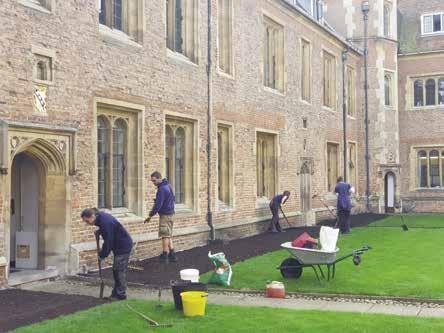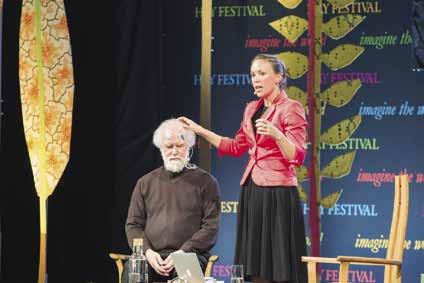
11 minute read
Henry Perronet Briggs: J M Munns Natural Disasters: E K M So
NATURAL DISASTERS
Are natural disasters really natural? The hazards themselves in the form of floods, earthquakes, volcanoes and hurricanes certainly are. The disastrous consequences of these natural phenomena are not natural at all, far from it. We as human beings in our pursuit to prosper, are settling in areas that are exposed to these natural events, putting ourselves in harm’s way, physically, socially, and financially. Professor James Jackson at the Department of Earth Sciences coined the phrase the ‘Fatal Attraction’ (Jackson, 2016). Our ancestors chose to settle where there was easy access to water with fertile and flat lands, which happen to be the exact locations where active faults, in creating breakages in the earth’s crust, elevate groundwater. As we continue to urbanise, large settlements along important trade routes have evolved into megacities, housing hundreds of thousands of people, and in the case of Tehran in Iran, over nine million are at risk from an inevitable earthquake. The last major earthquake was in 1830.
Advertisement
It is not just density of populations that aggravate consequences of natural hazards. We live in a global village where we and our neighbours in different countries are reliant on food, goods and services that travel thousands of miles before they reach our homes. We are therefore susceptible to naturally occurring events that are seemingly remote but now have major impacts on the global consumer and financial markets. A local flood just outside Bangkok in 2011 which hardly made mainstream news in the UK, brought the production of hard drives, cameras, and microchips to a standstill. A single facility in Bang Pa-In owned by Western Digital (Fig 1) produced one-quarter of the world’s supply of ‘sliders’, an integral part of hard-disk drives and halted global production for over two weeks.
Figure 1
The cost of global disasters is likely to continue to increase. An analysis of events worldwide between 1990 and 2008 carried out by Barthel and Neumayer (2012) concluded that ‘the accumulation of wealth in disaster-prone areas is and will always remain by far the most important driver of future economic disaster damage’. Any large weather event hitting densely populated areas now causes huge losses because the value of the infrastructure has increased tremendously. That was the case in August and September of 2017, with Hurricane Harvey closely followed by Maria devastating parts of the Gulf Coast and the Caribbean, tallying damage costs of over $125 billion and $91 billion respectively. Major flood events are also affecting many more people. In 2010, Pakistan saw its largest ever flood, affecting over 20 million people from the northern Himalayan mountains right down to the southern tip of the country and costing nearly $10 billion in losses (Fig 2). It has been battered by floods every year since then.
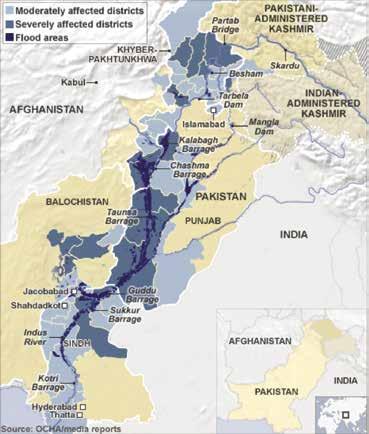
Figure 2
For the first time in a decade, the evolving risk landscape of the world has changed. According to the World Economic Forum, major natural disasters now feature in the top five global risks in terms of impact in 2017.
This has been reflected in the insurance industry, with Lloyd’s of London reporting its first loss in six years in March 2018, attributing most of the loss of £2billion to natural disasters. The question is why is this, are we experiencing more floods, earthquakes, and hurricanes?
Analyses of loss events worldwide carried out by Munich Re, global reinsurance company with a premium income of €31.6bn from reinsurance alone, supports an upward trend in the total number of natural hazard events recorded since 1980. According to their figures, the number of severe floods has almost tripled, and storms have nearly doubled, which they suggest in part is related to the impact of climate change. ‘It would not seem plausible that climate change doesn’t play a role in the substantial rise in weather-related disasters’, says Ernst Rauch, head of Munich Re’s Corporate Climate Centre.
Climate scientists believe that the frequency and severity of extremeweather events will increase as global temperatures continue to rise. The Intergovernmental Panel on Climate Change warns that some areas could become ‘increasingly marginal as places to live in’ (IPCC, 2012).
As Benjamin Franklin advised fire-threatened Philadelphians in 1736 ‘An ounce of prevention is worth a pound of cure’. ‘The quality of infrastructure we develop today will determine the level of risk tomorrow. To prevent new risks from being created we need to act now with solid foundation for science, technology and innovation.’ This was the message from Minister Kiren Rijiju, Minister of State for Home Affairs, India and a UNISDR Disaster Risk Reduction Champion addressing an Asian forum in Bangkok in 2016.
For some hazards, a major event does not repeat very often. There are often several hundred years between earthquakes or volcanic eruptions, even longer, so in general, we have time. The challenge is to convince those in authority and those potentially affected to do something. After the Long Beach, California earthquake 1933 which damaged 75% of public school buildings in the city, the government and city officials decided not to focus on vulnerable masonry residential houses but instead targeted their efforts on schools and public buildings. The California Joint Technical Committee on Earthquake Protection responded: ‘Strengthening of public buildings, however, is subject to the will of the people and there should be no delay in making these buildings—particularly school buildings—safe’. This led to the Field Act, the first state-wide building requirements in California that applied to all public-school buildings in the state. With the regeneration of buildings within cities and some luck that an earthquake has not occurred in the area since 1933, all the old residential masonry buildings have gradually been replaced over time. The city and State are now through
policies and building regulations, in a much better position to withstand the next event.
It is clear from recent large earthquakes that engineers and architects can design buildings that stay up in even the biggest events. Earthquakes do not kill people, buildings do. In studies examining fatalities due to earthquakes, it is found that over 75% of casualties are attributed to building collapses. The 2010 earthquake in Chile was the fifth largest recorded event worldwide in the last hundred years, yet it killed very few people. In Chile, the public can sue architects, engineers, and contractors if there is damage to their buildings in earthquakes. An acute public awareness and people working together to create a resilient built environment is the key to Chile’s success in living with earthquakes. This emphasises the need to educate the public, the construction industry, and scientists, so that everyone works together toward making better buildings.
The reason buildings collapse is because of poor construction, and builders trying to save money by cutting corners. We have seen this time and time again, reviewing the aftermaths of earthquakes during reconnaissance missions. The image below (Fig 3) shows a collapsed building after an earthquake in Taiwan in 2016 where tin cans were used as ‘fillers’ in a reinforced concrete wall.
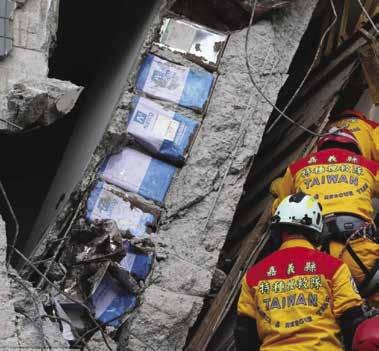
Figure 3
Bad construction is associated with problems of corruption and a lack of education. In the last decade, single events like the Wenchuan earthquake in China killing over 80,000 in 2008, and 200,000 deaths in Haiti in 2010. Most of these deaths were entirely preventable.
Even though as scientists, architects, and engineers, we have the knowhow to build for natural disasters and disaster management teams have plans in place to prepare and evacuate for these events, the messages are still not getting through to the people at risk. Despite multiple warnings of the incoming Hurricane Harvey in 2016 and orders to evacuate, images on our TV screens showed people refusing to leave their homes and subsequently mounting roofs of houses awaiting rescue. In this country, evacuation orders issued to communities in Great Yarmouth by the Environment Agency were largely ignored in 2017 (order issued on 13 January 2017). Fortunately, it was a near miss as the wind direction changed by three degrees, but the lack of action is of key concern to the Environment Agency, and next time they may not be so lucky. These examples are stark reminders that people do not always react the way we expect and that as practitioners in disaster risk reduction, we need to do more.
Globally, The Sendai Framework for Disaster Risk Reduction 2015–2030 is the first major agreement of the post-2015 development agenda, with seven targets and four priorities for action. It was endorsed by the UN General Assembly and is an international commitment to making a difference for poverty, health and resilience, setting actions to understanding disaster risk, strengthening risk governance and investment, and enhancing global resilience measures. At a city level, other recent global initiatives include the Rockefeller Foundation’s 100 Resilient Cities and the Lloyd’s Register’s Resilience Shift which aim to work with public and private institutes to encourage those involved with all aspects of civil protection and planning in order to share knowledge and experience that will enhance resilience.
At a community level, there is the challenge and a need to engage directly with the people at risk, and work together as they do in Chile and Japan for earthquakes, to educate and raise awareness and resilience. Naturally, the strategies used in different countries will vary and there will continue to be an emphasis on reducing the vulnerability of the built environment through improved buildings codes, implementation of regulations and building control. However, without a more concerted focus on people, those we are trying to protect, the progress of disaster risk reduction will be hampered. We have to improve and innovate in the ways we communicate, reviewing how we engage with people and what the messages are. At the Cambridge University Centre for Risk in the Built Environment (CURBE), we have always focused on solutions-driven research. Recent workshops conducted by the Environment Agency (EA) called Public Dialogues in the UK revealed the desire of communities to understand more about the scientific information behind the flood
warnings. Subsequently with the EA, we explored novel methods of explaining why hazards occur and their associated consequences, in Flood Narratives. Using physical models and story-telling kits, we created tools to allow the population at risk to explore alternative scenarios and take responsibilities for their decisions on risk mitigation. We all assess and take risks daily. Without full awareness and access to information, it is irresponsible of scientists, engineers, and disaster managers to expect the public to take action against risk that may not occur during their lifetimes.
Taking the Sendai priority actions forward is an example of building back better post-disaster. An earthquake in the Ludian county of China destroyed many rural rammed earth houses in the impoverished mountainous area in the northwest of the country in 2014. Even though there was a willingness for change, proposed modern building forms often transported from outside the county, or even country, were simply unaffordable to the local communities. Partnering with the Chinese University of Hong Kong and the Kunming University of Science and Technology in China, we created The Guangming house (Fig 4) which won the World Architectural Festival’s World Building of the Year 2017. A modest dwelling for an elderly couple that fully encapsulates the essence of designing for people, it embraced the ‘3Ls principle’ using local technology, local materials, and local labour. It succeeded in giving the couple and the local community confidence in an old building technique that was enhanced and tested using earthquake shake tables. It also respected their traditional ways of living.
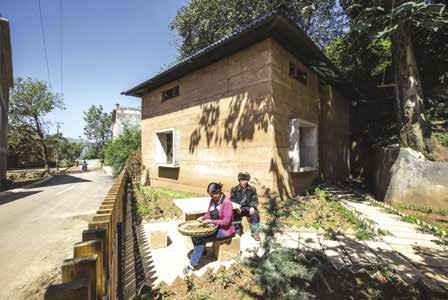
Figure 4
This and other community-based efforts may be a drop in the ocean, they reinforce the idea that to truly implement change, we must first understand and respect what people at risk from natural hazards prioritise and what their physical, social and financial constraints are. These efforts are crucial in helping them prepare and change their attitudes towards the inevitable, but critically not irrepressibly.
As we commemorate the 10th anniversary of the Wenchuan earthquake in China this year, there is hope that disaster risk reduction practitioners are making more noise and bringing disaster resilience to the top of the global development agenda. The hazard itself is not what creates the disaster, it is the quality of the housing and the social fabric. What is clear is that we cannot view this problem through a single lens on the physical environment but need to work together with social scientists, anthropologists, planners, public health specialists and psychologists to change the way we live and our attitudes to natural disasters. To make a significant difference and reduce the impact of these natural phenomena, we must learn to cohabit with our natural environment, and all that comes with it. E K M S
References: F Barthel and E Neumayer, A Trend Analysis of Normalized Insured Damage from Natural Disasters. Climatic Change (2012), 113 (2), pp 215-237. J A Jackson, Fatal attraction: living with earthquakes, the growth of villages into megacities, and earthquake vulnerability in the modern world (2006), Philosophical Transactions of the Royal Society of London A, 364 (1845), pp 1911-1925. DOI 10.1098/rsta.2006.1805.







